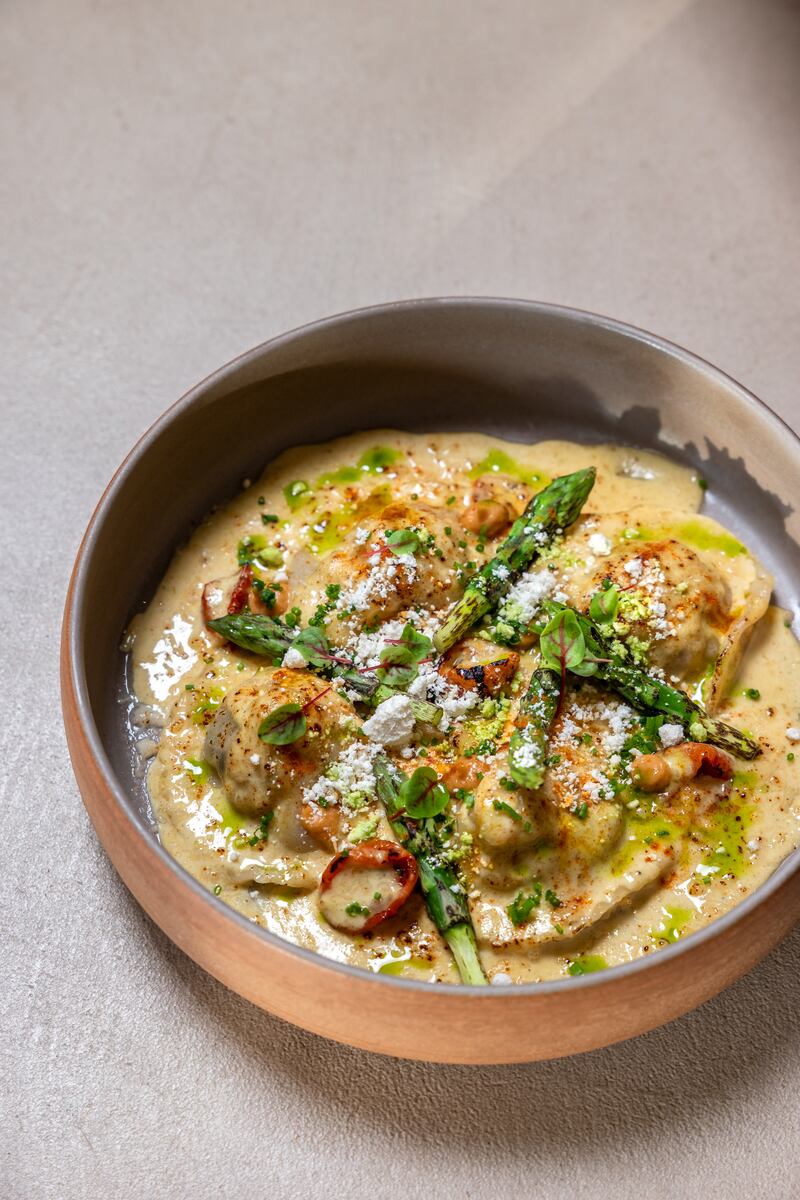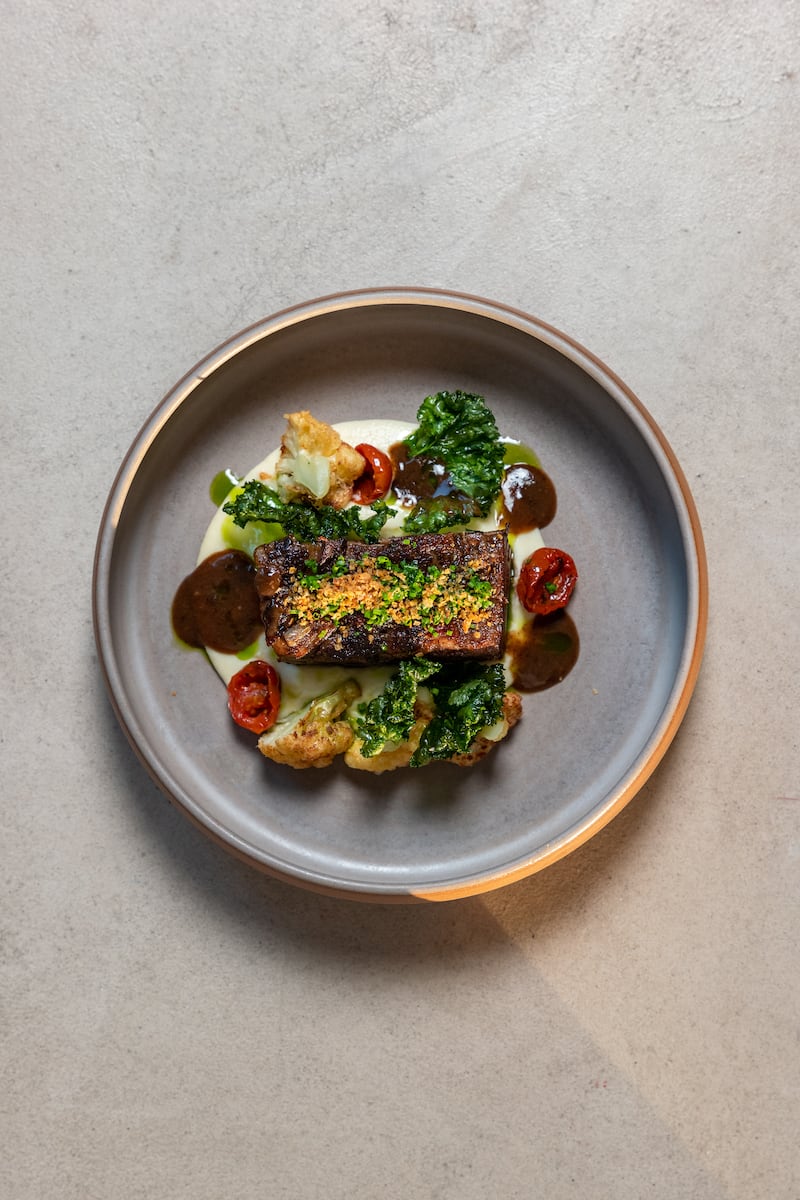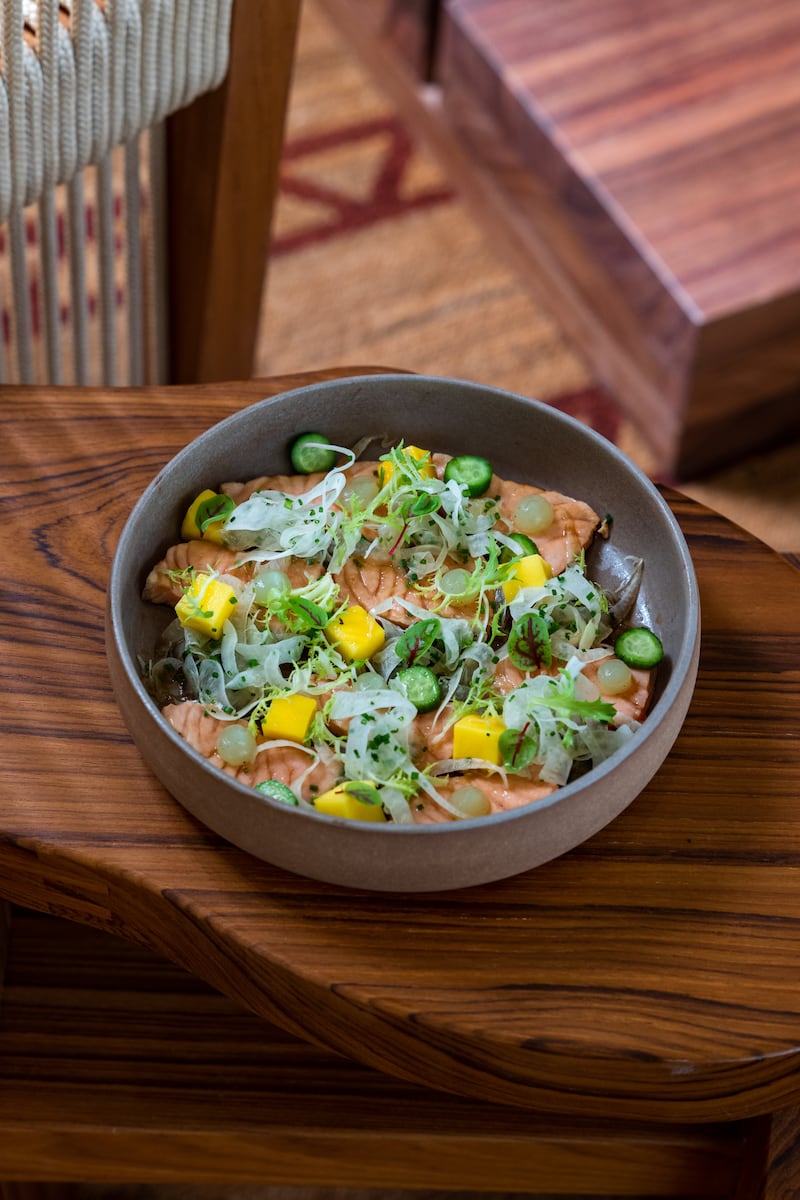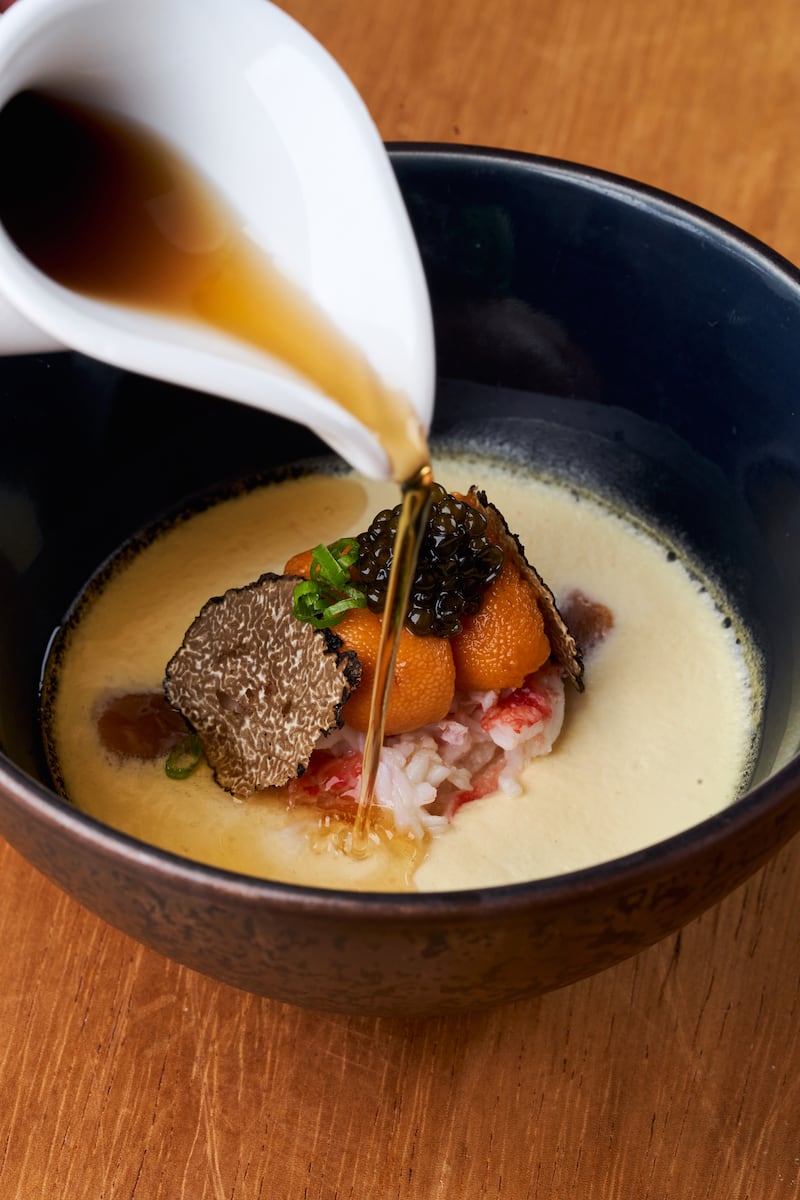The Michelin Guide Abu Dhabi ceremony was held at Louvre Abu Dhabi on Thursday, with four restaurants in the capital gaining one coveted culinary star each. Of these, 99 Sushi, Hakkasan and Talea by Antonio Guida retained their star from last November, while Erth was added to the list, making it the first restaurant serving Emirati food to now have a Michelin star.
Here The National presents the best dishes for residents and gastro-tourists to try in the capital's stellar venues.
Three dishes to try at 99 Sushi

99 Sushi, which is located in the Four Seasons Hotel on Al Maryah Island, specialises in “haute cuisine”, an expression that traditionally refers to high quality and meticulously prepared French fare, except it's exceptional Japanese food that's on offer here. Accordingly, the menu offers a strong selection of tartars and temaki plus three types of sushi, in addition to bluefin tuna, Wagyu and Kobe dishes.
Must-try dishes include the 99 Kobe sando (Dh360), a traditional Japanese sandwich filled with crispy cutlets of Kobe beef and tonkatsu sauce. It’s a brilliant, melt-in-the-mouth starter. The Japanese milk toast bread is moist and thinly cut to pack in more of the meat. Made in house, the tangy tonkatsu is a traditional Japanese barbecue sauce made from fermented vegetables. To this, South African head chef Thinus van der Westhuizen tells The National: “I add my own flair, which includes more crushed pepper and mustard, which is not normally within the scope of the traditional recipe.”
The 99 chawanmushi (Dh135) is another example of 99 Sushi’s twist on classic Japanese staples. The traditional savoury egg custard dish is blended with crab consomme, strips of king crab and caviar, and has a distinctly umami flavour. It is served lukewarm to appreciate the intricate textures at play. The umami comes courtesy of a frenzied flavour bomb of sweet, sour and salty profiles, while the silky consomme and crabmeat lend the dish a luxurious feel.
The final dish we'd recommend is 99 Sushi's statement piece. Created from scratch for the Abu Dhabi outpost, 99 Jewel (part of a tasting menu priced at Dh1,150 for two) is an eight-piece plate showcasing the restaurant's finest and most exclusive ingredients. The sushi rolls are filled with the aforementioned toro and the decadently fatty flavour of akami tuna. Laced with flecks of black truffle, each roll features a portion of Kaluga caviar (the more expensive beluga caviar is also available) and specks of 24k gold leaf.
Van der Westhuizen describes the dish as the menu’s show-stopper: “We created it to show people we mean business, in that we have top-tier products such as caviar and toro tuna, and we know how to do it well.”
The Kaluga caviar is used for more than just show. The glossy, firm pearls have a deep and nutty profile with a lingering aftertaste in the best of ways.
Read our full review here.
Three dishes to try at Erth
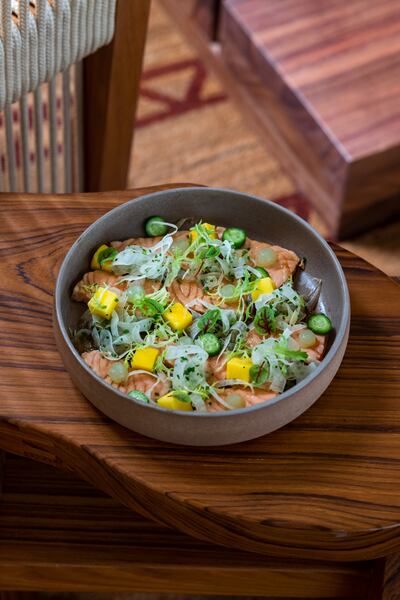
Dining at Erth, which is fittingly located at Qasr Al Hosn, feels like reading a love letter to the UAE. For those unaware of its inspiration or unfamiliar with Emirati cuisine, the only evidence is the mention of local sourcing in the menu. But begin to ask a few questions or turn over some crockery and the depth of the immersion is increasingly revealed. Erth is a departure from the traditional but is still completely Emirati, from its ingredients to its design and feel.
Must-try dishes include the torched salmon crudo (Dh75), served with cubes of mango and perfectly dressed shaved fennel. Incredible taste aside, the highlight here is that the salmon – much like the majority of produce at Erth – is locally farmed.
As Amit Arora, chief operating officer of Erth, told The National soon after the restaurant achieved its Michelin star: “We are passionate about supporting the local economy and creating a sustainable experience. To see that being recognised today is a proud moment. We support local farms in Abu Dhabi and Al Ain, and to provide a sustainable dining experience has always been our ethos.”
Another must-order is the margooga ravioli (Dh65). Instead of boiling dough balls in a tomato-braised vegetable stew, as tradition would dictate, the margooga ravioli encases the stew in a dumpling. It is slathered in a creamy Parmesan sauce and served alongside charred asparagus and confit tomatoes, also making it a perfect dish for vegetarians.
The Bzar-marinated beef short ribs (Dh105), meanwhile, promptly fall apart when prodded with a fork. The Emirati spice mix cuts through the rich meat, bone marrow sauce and creamy cauliflower puree to delicious effect.
Read our full review here.
Three dishes to try at Hakkasan
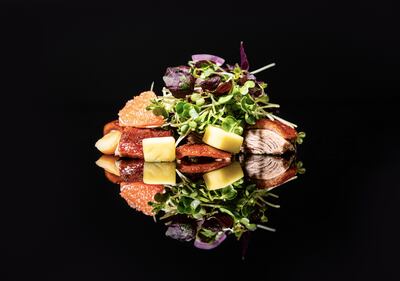
Hakkasan in Emirates Palace Mandarin Oriental serves globally approved Cantonese cuisine, which blends sophisticated cooking techniques with the freshest of ingredients.
A meal here would be incomplete without the supreme dim sum platter (Dh145). Instead of the standard chicken, beef and veggie fillings, more nuanced ingredients and flavours are on offer. The har gow, normally a pleated dumpling stuffed with prawn comes with the buttery and almost sweet notes of Chilean sea bass instead (although a prawn option is also available).
Hakkasan Abu Dhabi takes the shumai – another traditional Chinese dumpling normally filled with chopped or minced mutton, spring onion and ginger – in a vibrant new direction with diced chicken, abalone and pearls of caviar.
It is at once impactful, playful and elegant – all attributes that chef Lee Kok Hua says are essential to the restaurant’s ethos.
The crispy duck salad (Dh175), meanwhile, is Hakkasan Abu Dhabi's best-selling dish – and for good reason. The duck is perfectly cooked and the citric sharpness of the pomelo is undercut by pine nuts and shallots. “Preparing the duck takes more than 10 hours to make it softer before we deep-fry it to make it crispy,” Hua tells The National. “We use pomelo because it is delicious, juicy and leaves an overall refreshing taste.”
Finally, meat-eaters would do well to order the stir-fry black pepper rib eye beef (Dh198), which is popular precisely because of its familiarity. The sauce is rich without overpowering the succulent beef strips. A flamboyant touch arrives – we are in Hakkasan, after all – courtesy of a layer of shredded crispy prawn crackers shaped like a basket holding the dish within.
“The dish has become so popular that it is considered as an Asian food favourite,” Hua says. “But to do it in true Cantonese fashion, it is all about flavour and balance.”
Read our full review here.
Three dishes to try at Talea by Antonio Guida
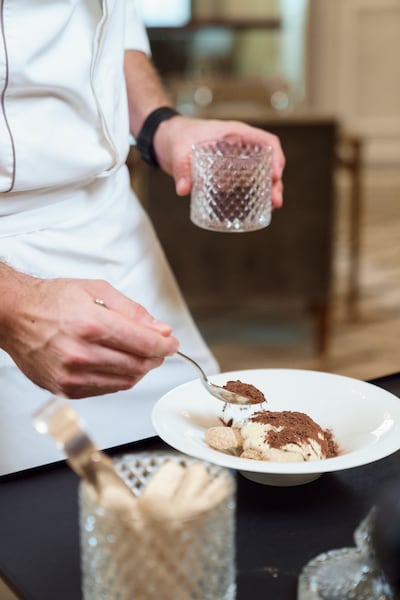
Also located in Emirates Palace, the Abu Dhabi outpost of the Italian restaurant is run by Antonio Guida's protege Luigi Stinga, who was the recipient of the inaugural Michelin Guide Abu Dhabi's Young Chef Award.
The restaurant's best-selling dish is fettuccina alla nerano (Dh135). It's a traditional Italian pasta dish made with fried courgette, basil and Parmesan that, as Stinga tells The National, had management initially suspicious at how simple it was.
“This is a dish I grew up with in my village near Sorrento and it is full of flavour and just makes you feel loved,” he says. “I knew that once people try it, they will enjoy it.”
The most enjoyable aspect of the dish is its contrasting flavours. The Parmesan, for instance, creates a sultry sauce that's still not too heavy, while the finely cut courgette slices are fried yet not oily at all. Crispy and garnished with basil, the overall flavour is earthy without being overpowering.
A must-have appetiser is the vitello tonnato (Dh140). The chilled sliced veal dish comes with a tuna sauce piped around it and capers, and it’s topped with shreds of fresh, crisp celery. It’s a light and refreshing start, with delicate yet distinct flavours. The saltiness and tartness of this appetiser is balanced beautifully by the thin slices of meat and peppery veg. The dish is a classic in Milan, often eaten during the religious Feast of the Assumption each summer and it’s a delight that should not be missed at Talea.
A touch of the theatrical can be found in dessert. The tiramisu (Dh100) is made and served tableside, and sticks to the traditional ingredients of ladyfinger biscuits, a sauce of egg yolks, sugar and mascarpone cheese, and a drizzle of medium to dark roast coffee and cocoa powder.
It is all prepared expertly within minutes and, while relatively simple to assemble, Stinga says a tiramisu lives or dies by the freshness of its ingredients. “There are certain dishes that it's best not to reinvent and, instead, focus on what makes it good,” he says.
“With the Tiramisu, the biscuits are baked in-house and the sauce is made from scratch. When these things are home-made, it feels softer and lighter and you don't walk away from dinner feeling heavy or guilty.”
Read our full review here.
